A Comprehensive Report on Gender Discrimination in the Workforce
VerifiedAdded on 2022/01/08
|20
|4109
|140
Report
AI Summary
This report, focusing on gender discrimination in the workforce, begins with an introduction outlining the research's purpose, scope, aims, objectives, and research questions. It investigates the current state of gender inequality, reasons behind it, and its consequences on employees. The literature review explores existing studies on the topic, including the scenario in the UK, reasons, and impacts. The methodology section details the research philosophy (positivism), approach (deductive), and design (explanatory), along with data collection (primary, using surveys and interviews) and analysis techniques. The findings, based on quantitative analysis (surveys) and qualitative analysis (interviews), reveal the gender distribution, age, and experience of respondents and their perspectives on discrimination. The report concludes with recommendations for mitigating gender discrimination and references supporting literature.
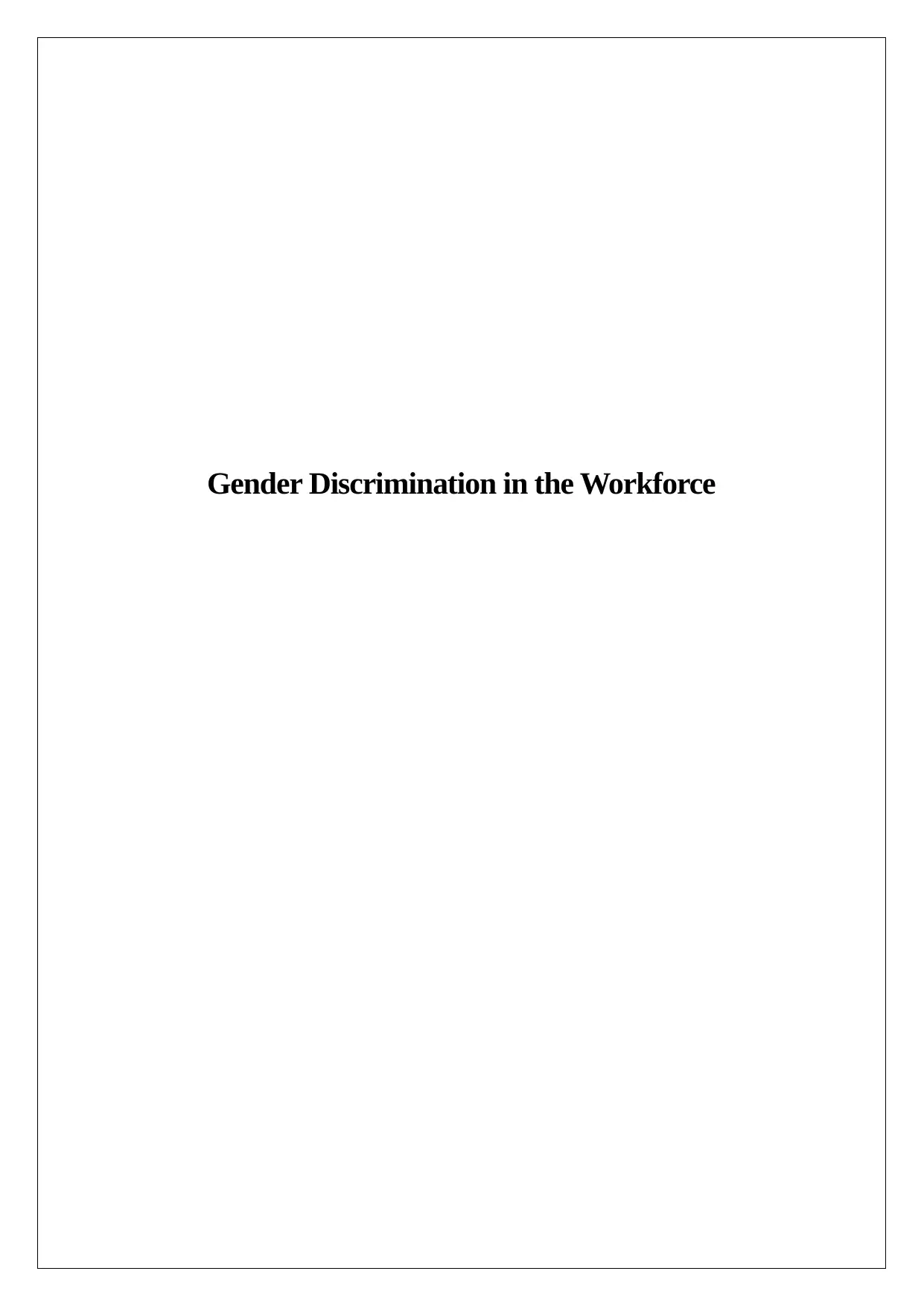
Gender Discrimination in the Workforce
Paraphrase This Document
Need a fresh take? Get an instant paraphrase of this document with our AI Paraphraser
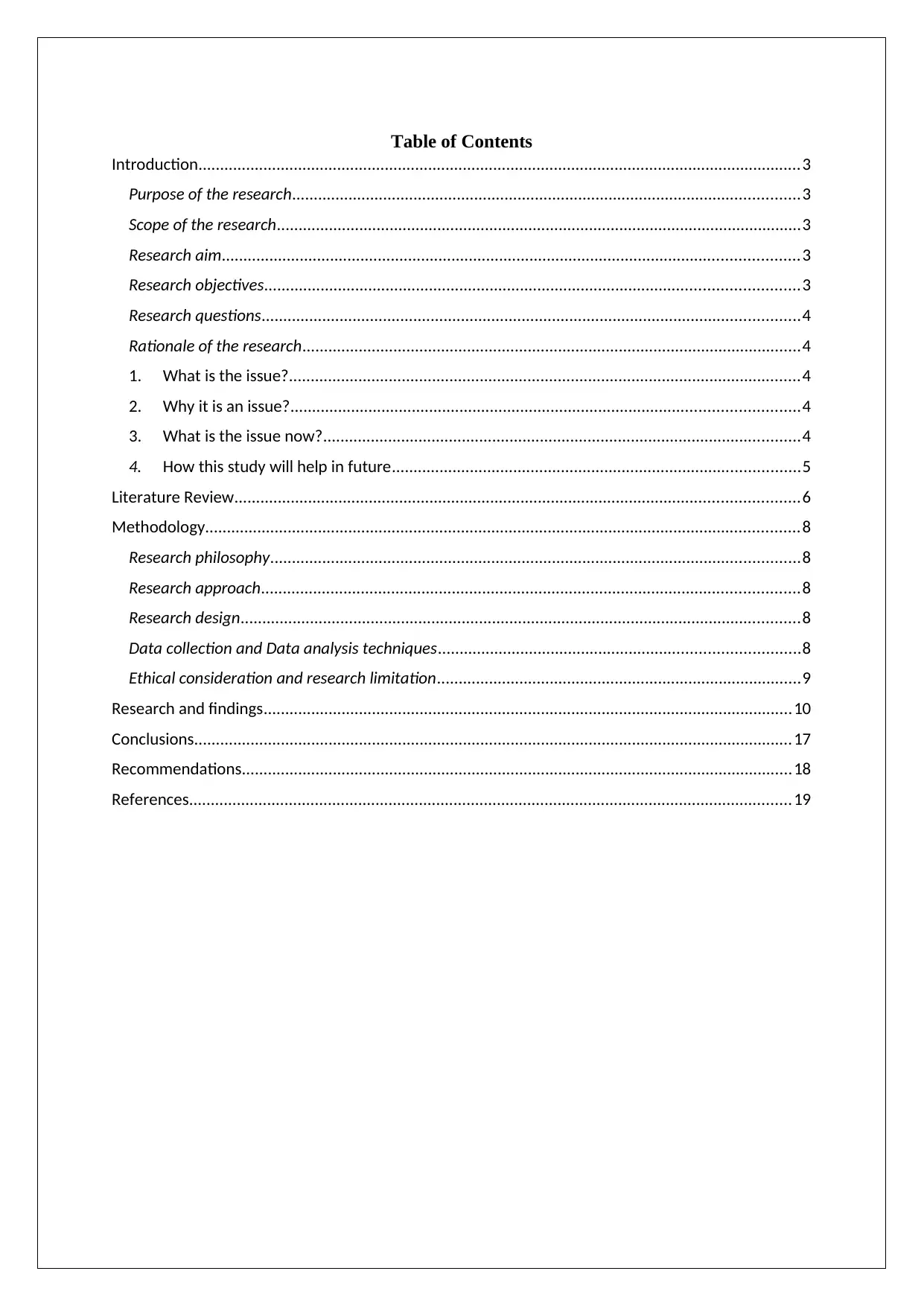
Table of Contents
Introduction...........................................................................................................................................3
Purpose of the research.....................................................................................................................3
Scope of the research.........................................................................................................................3
Research aim.....................................................................................................................................3
Research objectives...........................................................................................................................3
Research questions............................................................................................................................4
Rationale of the research...................................................................................................................4
1. What is the issue?......................................................................................................................4
2. Why it is an issue?.....................................................................................................................4
3. What is the issue now?..............................................................................................................4
4. How this study will help in future..............................................................................................5
Literature Review..................................................................................................................................6
Methodology.........................................................................................................................................8
Research philosophy..........................................................................................................................8
Research approach............................................................................................................................8
Research design.................................................................................................................................8
Data collection and Data analysis techniques...................................................................................8
Ethical consideration and research limitation....................................................................................9
Research and findings..........................................................................................................................10
Conclusions..........................................................................................................................................17
Recommendations...............................................................................................................................18
References...........................................................................................................................................19
Introduction...........................................................................................................................................3
Purpose of the research.....................................................................................................................3
Scope of the research.........................................................................................................................3
Research aim.....................................................................................................................................3
Research objectives...........................................................................................................................3
Research questions............................................................................................................................4
Rationale of the research...................................................................................................................4
1. What is the issue?......................................................................................................................4
2. Why it is an issue?.....................................................................................................................4
3. What is the issue now?..............................................................................................................4
4. How this study will help in future..............................................................................................5
Literature Review..................................................................................................................................6
Methodology.........................................................................................................................................8
Research philosophy..........................................................................................................................8
Research approach............................................................................................................................8
Research design.................................................................................................................................8
Data collection and Data analysis techniques...................................................................................8
Ethical consideration and research limitation....................................................................................9
Research and findings..........................................................................................................................10
Conclusions..........................................................................................................................................17
Recommendations...............................................................................................................................18
References...........................................................................................................................................19
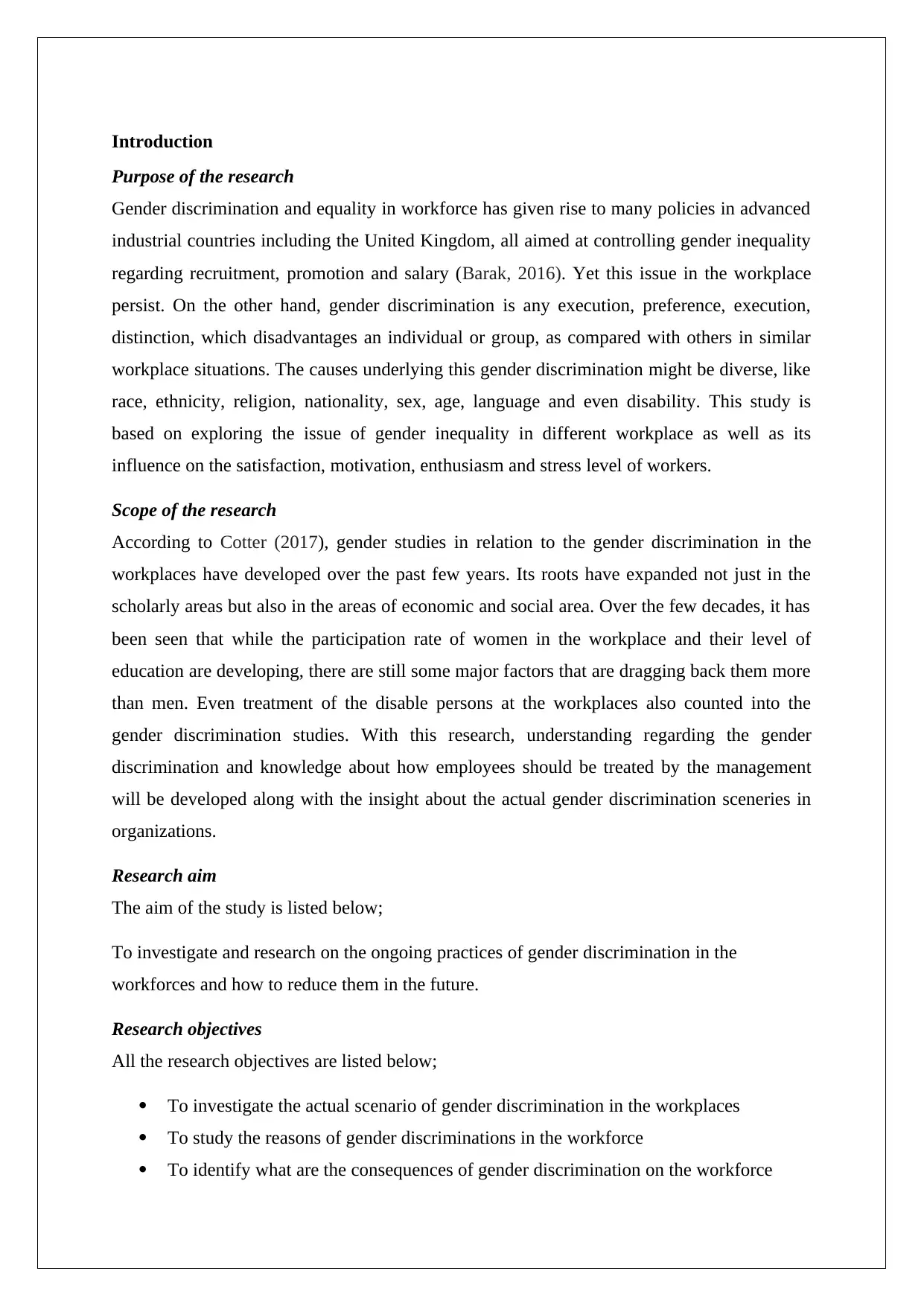
Introduction
Purpose of the research
Gender discrimination and equality in workforce has given rise to many policies in advanced
industrial countries including the United Kingdom, all aimed at controlling gender inequality
regarding recruitment, promotion and salary (Barak, 2016). Yet this issue in the workplace
persist. On the other hand, gender discrimination is any execution, preference, execution,
distinction, which disadvantages an individual or group, as compared with others in similar
workplace situations. The causes underlying this gender discrimination might be diverse, like
race, ethnicity, religion, nationality, sex, age, language and even disability. This study is
based on exploring the issue of gender inequality in different workplace as well as its
influence on the satisfaction, motivation, enthusiasm and stress level of workers.
Scope of the research
According to Cotter (2017), gender studies in relation to the gender discrimination in the
workplaces have developed over the past few years. Its roots have expanded not just in the
scholarly areas but also in the areas of economic and social area. Over the few decades, it has
been seen that while the participation rate of women in the workplace and their level of
education are developing, there are still some major factors that are dragging back them more
than men. Even treatment of the disable persons at the workplaces also counted into the
gender discrimination studies. With this research, understanding regarding the gender
discrimination and knowledge about how employees should be treated by the management
will be developed along with the insight about the actual gender discrimination sceneries in
organizations.
Research aim
The aim of the study is listed below;
To investigate and research on the ongoing practices of gender discrimination in the
workforces and how to reduce them in the future.
Research objectives
All the research objectives are listed below;
To investigate the actual scenario of gender discrimination in the workplaces
To study the reasons of gender discriminations in the workforce
To identify what are the consequences of gender discrimination on the workforce
Purpose of the research
Gender discrimination and equality in workforce has given rise to many policies in advanced
industrial countries including the United Kingdom, all aimed at controlling gender inequality
regarding recruitment, promotion and salary (Barak, 2016). Yet this issue in the workplace
persist. On the other hand, gender discrimination is any execution, preference, execution,
distinction, which disadvantages an individual or group, as compared with others in similar
workplace situations. The causes underlying this gender discrimination might be diverse, like
race, ethnicity, religion, nationality, sex, age, language and even disability. This study is
based on exploring the issue of gender inequality in different workplace as well as its
influence on the satisfaction, motivation, enthusiasm and stress level of workers.
Scope of the research
According to Cotter (2017), gender studies in relation to the gender discrimination in the
workplaces have developed over the past few years. Its roots have expanded not just in the
scholarly areas but also in the areas of economic and social area. Over the few decades, it has
been seen that while the participation rate of women in the workplace and their level of
education are developing, there are still some major factors that are dragging back them more
than men. Even treatment of the disable persons at the workplaces also counted into the
gender discrimination studies. With this research, understanding regarding the gender
discrimination and knowledge about how employees should be treated by the management
will be developed along with the insight about the actual gender discrimination sceneries in
organizations.
Research aim
The aim of the study is listed below;
To investigate and research on the ongoing practices of gender discrimination in the
workforces and how to reduce them in the future.
Research objectives
All the research objectives are listed below;
To investigate the actual scenario of gender discrimination in the workplaces
To study the reasons of gender discriminations in the workforce
To identify what are the consequences of gender discrimination on the workforce
⊘ This is a preview!⊘
Do you want full access?
Subscribe today to unlock all pages.

Trusted by 1+ million students worldwide
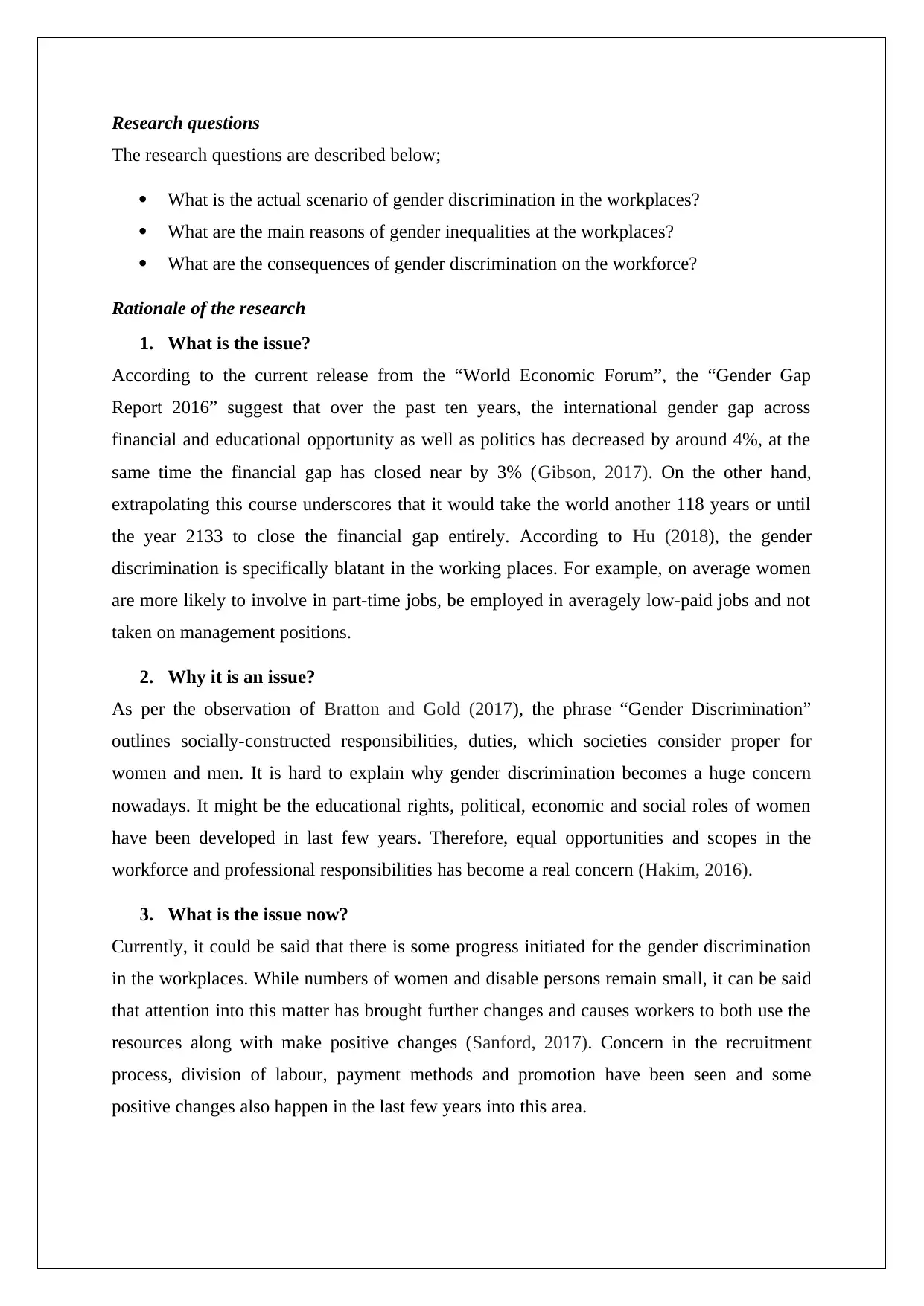
Research questions
The research questions are described below;
What is the actual scenario of gender discrimination in the workplaces?
What are the main reasons of gender inequalities at the workplaces?
What are the consequences of gender discrimination on the workforce?
Rationale of the research
1. What is the issue?
According to the current release from the “World Economic Forum”, the “Gender Gap
Report 2016” suggest that over the past ten years, the international gender gap across
financial and educational opportunity as well as politics has decreased by around 4%, at the
same time the financial gap has closed near by 3% (Gibson, 2017). On the other hand,
extrapolating this course underscores that it would take the world another 118 years or until
the year 2133 to close the financial gap entirely. According to Hu (2018), the gender
discrimination is specifically blatant in the working places. For example, on average women
are more likely to involve in part-time jobs, be employed in averagely low-paid jobs and not
taken on management positions.
2. Why it is an issue?
As per the observation of Bratton and Gold (2017), the phrase “Gender Discrimination”
outlines socially-constructed responsibilities, duties, which societies consider proper for
women and men. It is hard to explain why gender discrimination becomes a huge concern
nowadays. It might be the educational rights, political, economic and social roles of women
have been developed in last few years. Therefore, equal opportunities and scopes in the
workforce and professional responsibilities has become a real concern (Hakim, 2016).
3. What is the issue now?
Currently, it could be said that there is some progress initiated for the gender discrimination
in the workplaces. While numbers of women and disable persons remain small, it can be said
that attention into this matter has brought further changes and causes workers to both use the
resources along with make positive changes (Sanford, 2017). Concern in the recruitment
process, division of labour, payment methods and promotion have been seen and some
positive changes also happen in the last few years into this area.
The research questions are described below;
What is the actual scenario of gender discrimination in the workplaces?
What are the main reasons of gender inequalities at the workplaces?
What are the consequences of gender discrimination on the workforce?
Rationale of the research
1. What is the issue?
According to the current release from the “World Economic Forum”, the “Gender Gap
Report 2016” suggest that over the past ten years, the international gender gap across
financial and educational opportunity as well as politics has decreased by around 4%, at the
same time the financial gap has closed near by 3% (Gibson, 2017). On the other hand,
extrapolating this course underscores that it would take the world another 118 years or until
the year 2133 to close the financial gap entirely. According to Hu (2018), the gender
discrimination is specifically blatant in the working places. For example, on average women
are more likely to involve in part-time jobs, be employed in averagely low-paid jobs and not
taken on management positions.
2. Why it is an issue?
As per the observation of Bratton and Gold (2017), the phrase “Gender Discrimination”
outlines socially-constructed responsibilities, duties, which societies consider proper for
women and men. It is hard to explain why gender discrimination becomes a huge concern
nowadays. It might be the educational rights, political, economic and social roles of women
have been developed in last few years. Therefore, equal opportunities and scopes in the
workforce and professional responsibilities has become a real concern (Hakim, 2016).
3. What is the issue now?
Currently, it could be said that there is some progress initiated for the gender discrimination
in the workplaces. While numbers of women and disable persons remain small, it can be said
that attention into this matter has brought further changes and causes workers to both use the
resources along with make positive changes (Sanford, 2017). Concern in the recruitment
process, division of labour, payment methods and promotion have been seen and some
positive changes also happen in the last few years into this area.
Paraphrase This Document
Need a fresh take? Get an instant paraphrase of this document with our AI Paraphraser
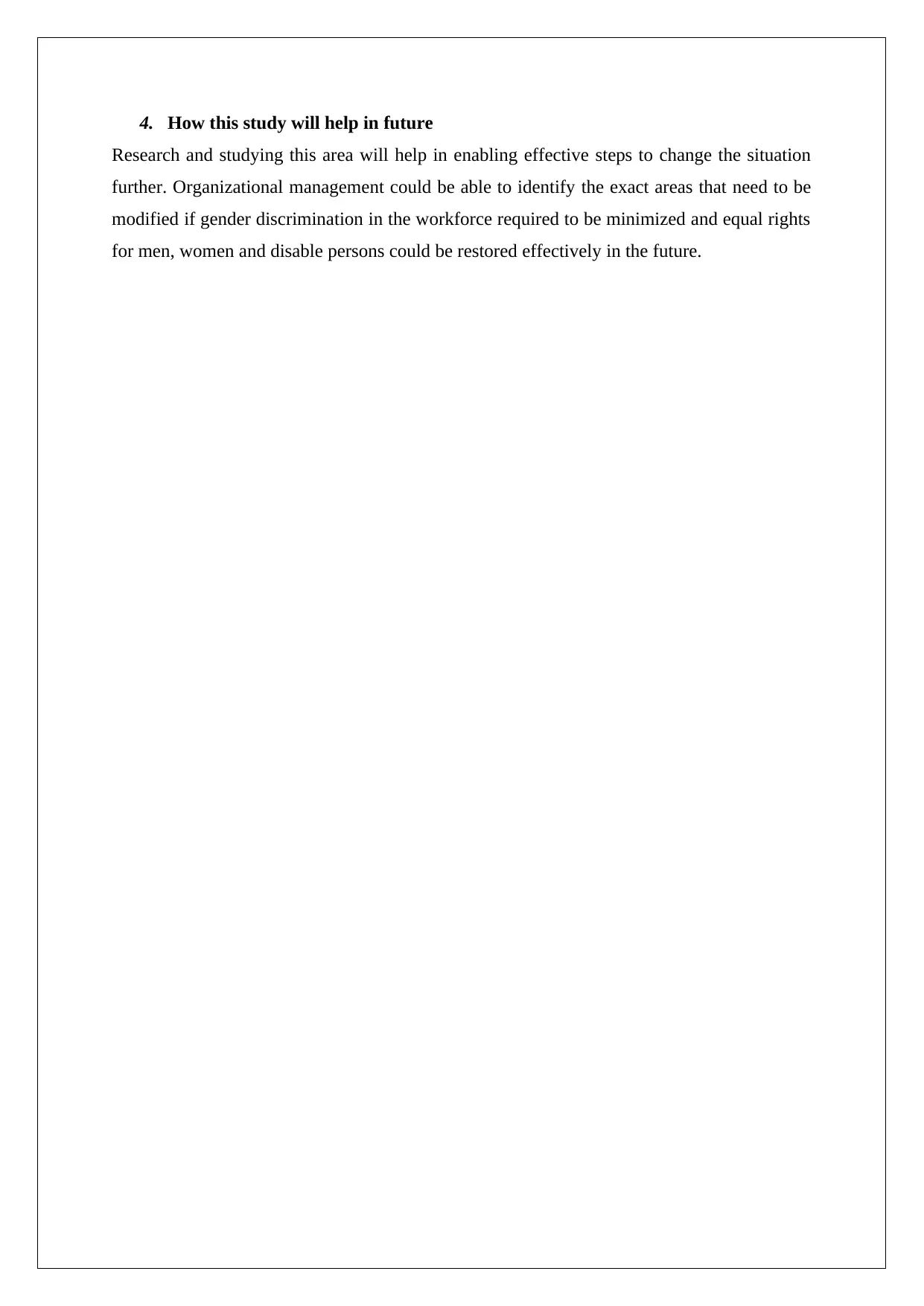
4. How this study will help in future
Research and studying this area will help in enabling effective steps to change the situation
further. Organizational management could be able to identify the exact areas that need to be
modified if gender discrimination in the workforce required to be minimized and equal rights
for men, women and disable persons could be restored effectively in the future.
Research and studying this area will help in enabling effective steps to change the situation
further. Organizational management could be able to identify the exact areas that need to be
modified if gender discrimination in the workforce required to be minimized and equal rights
for men, women and disable persons could be restored effectively in the future.
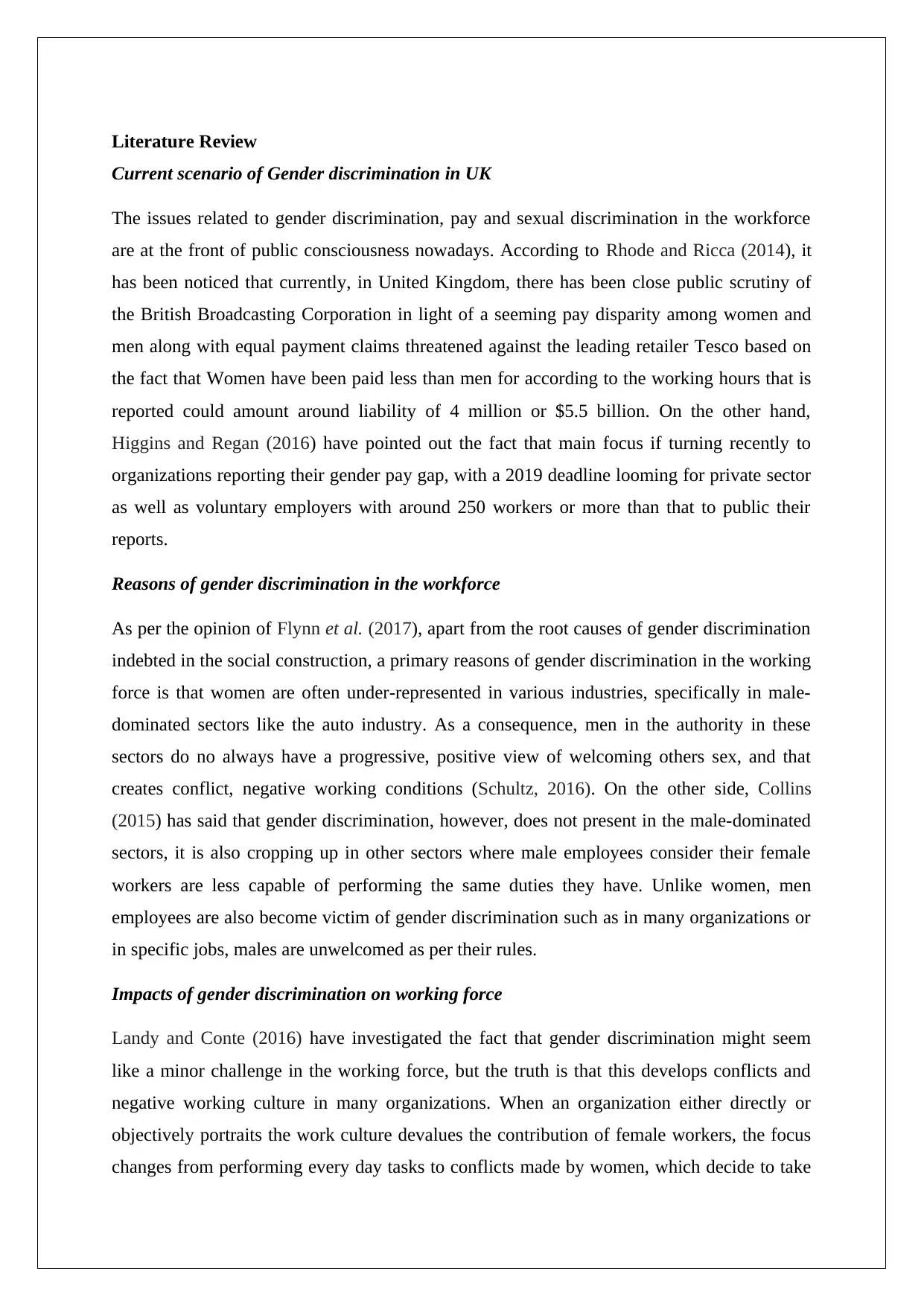
Literature Review
Current scenario of Gender discrimination in UK
The issues related to gender discrimination, pay and sexual discrimination in the workforce
are at the front of public consciousness nowadays. According to Rhode and Ricca (2014), it
has been noticed that currently, in United Kingdom, there has been close public scrutiny of
the British Broadcasting Corporation in light of a seeming pay disparity among women and
men along with equal payment claims threatened against the leading retailer Tesco based on
the fact that Women have been paid less than men for according to the working hours that is
reported could amount around liability of 4 million or $5.5 billion. On the other hand,
Higgins and Regan (2016) have pointed out the fact that main focus if turning recently to
organizations reporting their gender pay gap, with a 2019 deadline looming for private sector
as well as voluntary employers with around 250 workers or more than that to public their
reports.
Reasons of gender discrimination in the workforce
As per the opinion of Flynn et al. (2017), apart from the root causes of gender discrimination
indebted in the social construction, a primary reasons of gender discrimination in the working
force is that women are often under-represented in various industries, specifically in male-
dominated sectors like the auto industry. As a consequence, men in the authority in these
sectors do no always have a progressive, positive view of welcoming others sex, and that
creates conflict, negative working conditions (Schultz, 2016). On the other side, Collins
(2015) has said that gender discrimination, however, does not present in the male-dominated
sectors, it is also cropping up in other sectors where male employees consider their female
workers are less capable of performing the same duties they have. Unlike women, men
employees are also become victim of gender discrimination such as in many organizations or
in specific jobs, males are unwelcomed as per their rules.
Impacts of gender discrimination on working force
Landy and Conte (2016) have investigated the fact that gender discrimination might seem
like a minor challenge in the working force, but the truth is that this develops conflicts and
negative working culture in many organizations. When an organization either directly or
objectively portraits the work culture devalues the contribution of female workers, the focus
changes from performing every day tasks to conflicts made by women, which decide to take
Current scenario of Gender discrimination in UK
The issues related to gender discrimination, pay and sexual discrimination in the workforce
are at the front of public consciousness nowadays. According to Rhode and Ricca (2014), it
has been noticed that currently, in United Kingdom, there has been close public scrutiny of
the British Broadcasting Corporation in light of a seeming pay disparity among women and
men along with equal payment claims threatened against the leading retailer Tesco based on
the fact that Women have been paid less than men for according to the working hours that is
reported could amount around liability of 4 million or $5.5 billion. On the other hand,
Higgins and Regan (2016) have pointed out the fact that main focus if turning recently to
organizations reporting their gender pay gap, with a 2019 deadline looming for private sector
as well as voluntary employers with around 250 workers or more than that to public their
reports.
Reasons of gender discrimination in the workforce
As per the opinion of Flynn et al. (2017), apart from the root causes of gender discrimination
indebted in the social construction, a primary reasons of gender discrimination in the working
force is that women are often under-represented in various industries, specifically in male-
dominated sectors like the auto industry. As a consequence, men in the authority in these
sectors do no always have a progressive, positive view of welcoming others sex, and that
creates conflict, negative working conditions (Schultz, 2016). On the other side, Collins
(2015) has said that gender discrimination, however, does not present in the male-dominated
sectors, it is also cropping up in other sectors where male employees consider their female
workers are less capable of performing the same duties they have. Unlike women, men
employees are also become victim of gender discrimination such as in many organizations or
in specific jobs, males are unwelcomed as per their rules.
Impacts of gender discrimination on working force
Landy and Conte (2016) have investigated the fact that gender discrimination might seem
like a minor challenge in the working force, but the truth is that this develops conflicts and
negative working culture in many organizations. When an organization either directly or
objectively portraits the work culture devalues the contribution of female workers, the focus
changes from performing every day tasks to conflicts made by women, which decide to take
⊘ This is a preview!⊘
Do you want full access?
Subscribe today to unlock all pages.

Trusted by 1+ million students worldwide
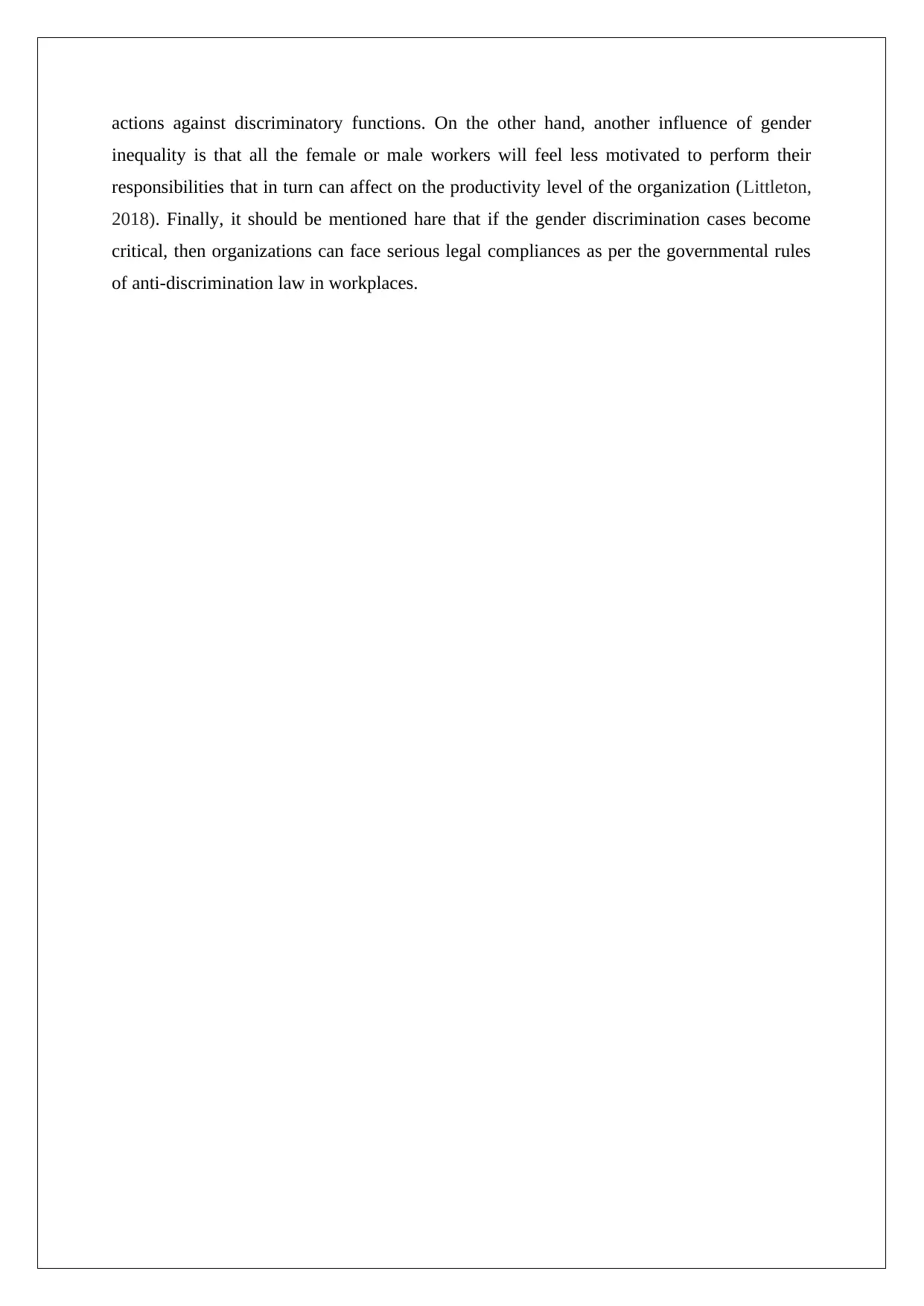
actions against discriminatory functions. On the other hand, another influence of gender
inequality is that all the female or male workers will feel less motivated to perform their
responsibilities that in turn can affect on the productivity level of the organization (Littleton,
2018). Finally, it should be mentioned hare that if the gender discrimination cases become
critical, then organizations can face serious legal compliances as per the governmental rules
of anti-discrimination law in workplaces.
inequality is that all the female or male workers will feel less motivated to perform their
responsibilities that in turn can affect on the productivity level of the organization (Littleton,
2018). Finally, it should be mentioned hare that if the gender discrimination cases become
critical, then organizations can face serious legal compliances as per the governmental rules
of anti-discrimination law in workplaces.
Paraphrase This Document
Need a fresh take? Get an instant paraphrase of this document with our AI Paraphraser
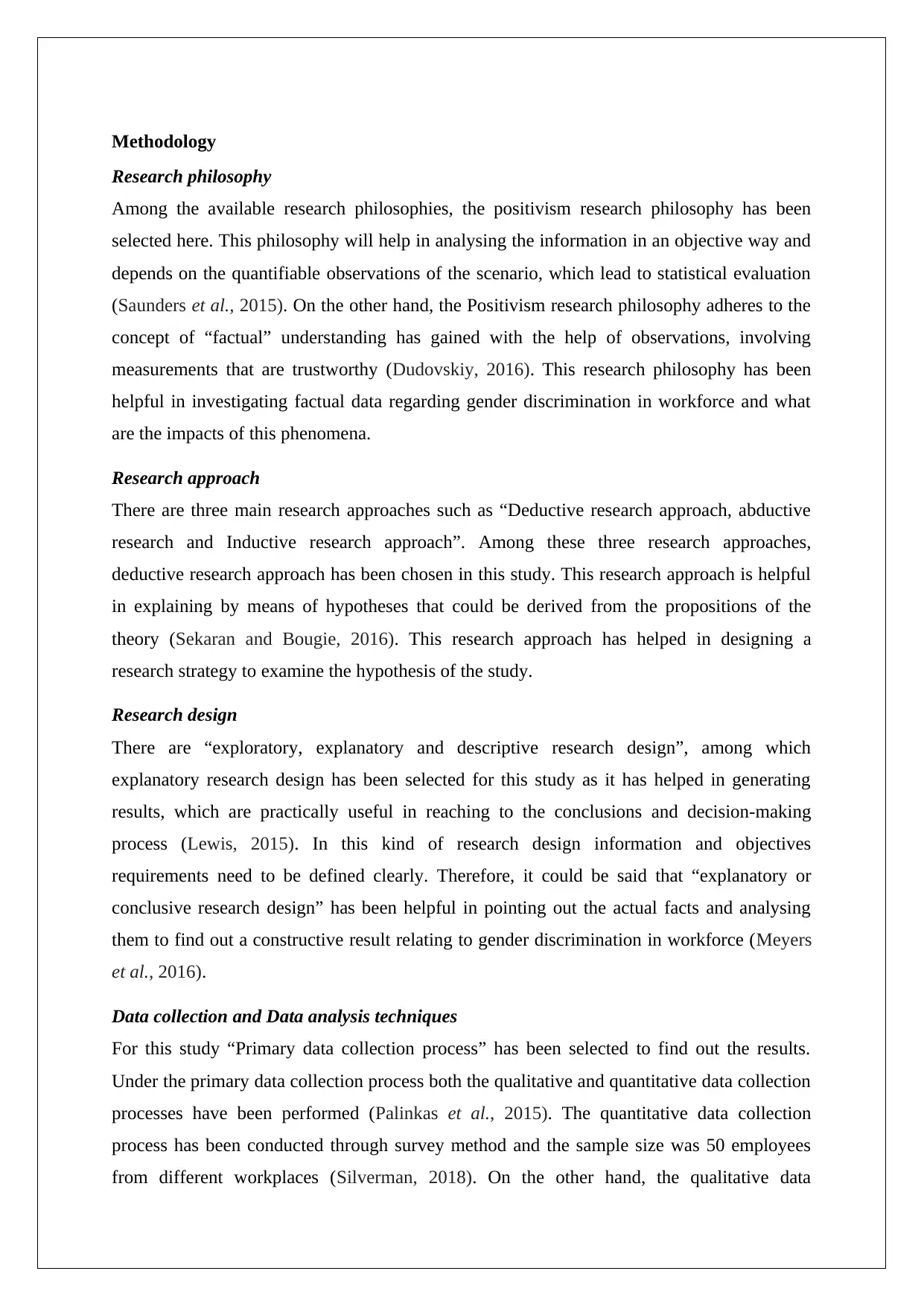
Methodology
Research philosophy
Among the available research philosophies, the positivism research philosophy has been
selected here. This philosophy will help in analysing the information in an objective way and
depends on the quantifiable observations of the scenario, which lead to statistical evaluation
(Saunders et al., 2015). On the other hand, the Positivism research philosophy adheres to the
concept of “factual” understanding has gained with the help of observations, involving
measurements that are trustworthy (Dudovskiy, 2016). This research philosophy has been
helpful in investigating factual data regarding gender discrimination in workforce and what
are the impacts of this phenomena.
Research approach
There are three main research approaches such as “Deductive research approach, abductive
research and Inductive research approach”. Among these three research approaches,
deductive research approach has been chosen in this study. This research approach is helpful
in explaining by means of hypotheses that could be derived from the propositions of the
theory (Sekaran and Bougie, 2016). This research approach has helped in designing a
research strategy to examine the hypothesis of the study.
Research design
There are “exploratory, explanatory and descriptive research design”, among which
explanatory research design has been selected for this study as it has helped in generating
results, which are practically useful in reaching to the conclusions and decision-making
process (Lewis, 2015). In this kind of research design information and objectives
requirements need to be defined clearly. Therefore, it could be said that “explanatory or
conclusive research design” has been helpful in pointing out the actual facts and analysing
them to find out a constructive result relating to gender discrimination in workforce (Meyers
et al., 2016).
Data collection and Data analysis techniques
For this study “Primary data collection process” has been selected to find out the results.
Under the primary data collection process both the qualitative and quantitative data collection
processes have been performed (Palinkas et al., 2015). The quantitative data collection
process has been conducted through survey method and the sample size was 50 employees
from different workplaces (Silverman, 2018). On the other hand, the qualitative data
Research philosophy
Among the available research philosophies, the positivism research philosophy has been
selected here. This philosophy will help in analysing the information in an objective way and
depends on the quantifiable observations of the scenario, which lead to statistical evaluation
(Saunders et al., 2015). On the other hand, the Positivism research philosophy adheres to the
concept of “factual” understanding has gained with the help of observations, involving
measurements that are trustworthy (Dudovskiy, 2016). This research philosophy has been
helpful in investigating factual data regarding gender discrimination in workforce and what
are the impacts of this phenomena.
Research approach
There are three main research approaches such as “Deductive research approach, abductive
research and Inductive research approach”. Among these three research approaches,
deductive research approach has been chosen in this study. This research approach is helpful
in explaining by means of hypotheses that could be derived from the propositions of the
theory (Sekaran and Bougie, 2016). This research approach has helped in designing a
research strategy to examine the hypothesis of the study.
Research design
There are “exploratory, explanatory and descriptive research design”, among which
explanatory research design has been selected for this study as it has helped in generating
results, which are practically useful in reaching to the conclusions and decision-making
process (Lewis, 2015). In this kind of research design information and objectives
requirements need to be defined clearly. Therefore, it could be said that “explanatory or
conclusive research design” has been helpful in pointing out the actual facts and analysing
them to find out a constructive result relating to gender discrimination in workforce (Meyers
et al., 2016).
Data collection and Data analysis techniques
For this study “Primary data collection process” has been selected to find out the results.
Under the primary data collection process both the qualitative and quantitative data collection
processes have been performed (Palinkas et al., 2015). The quantitative data collection
process has been conducted through survey method and the sample size was 50 employees
from different workplaces (Silverman, 2018). On the other hand, the qualitative data
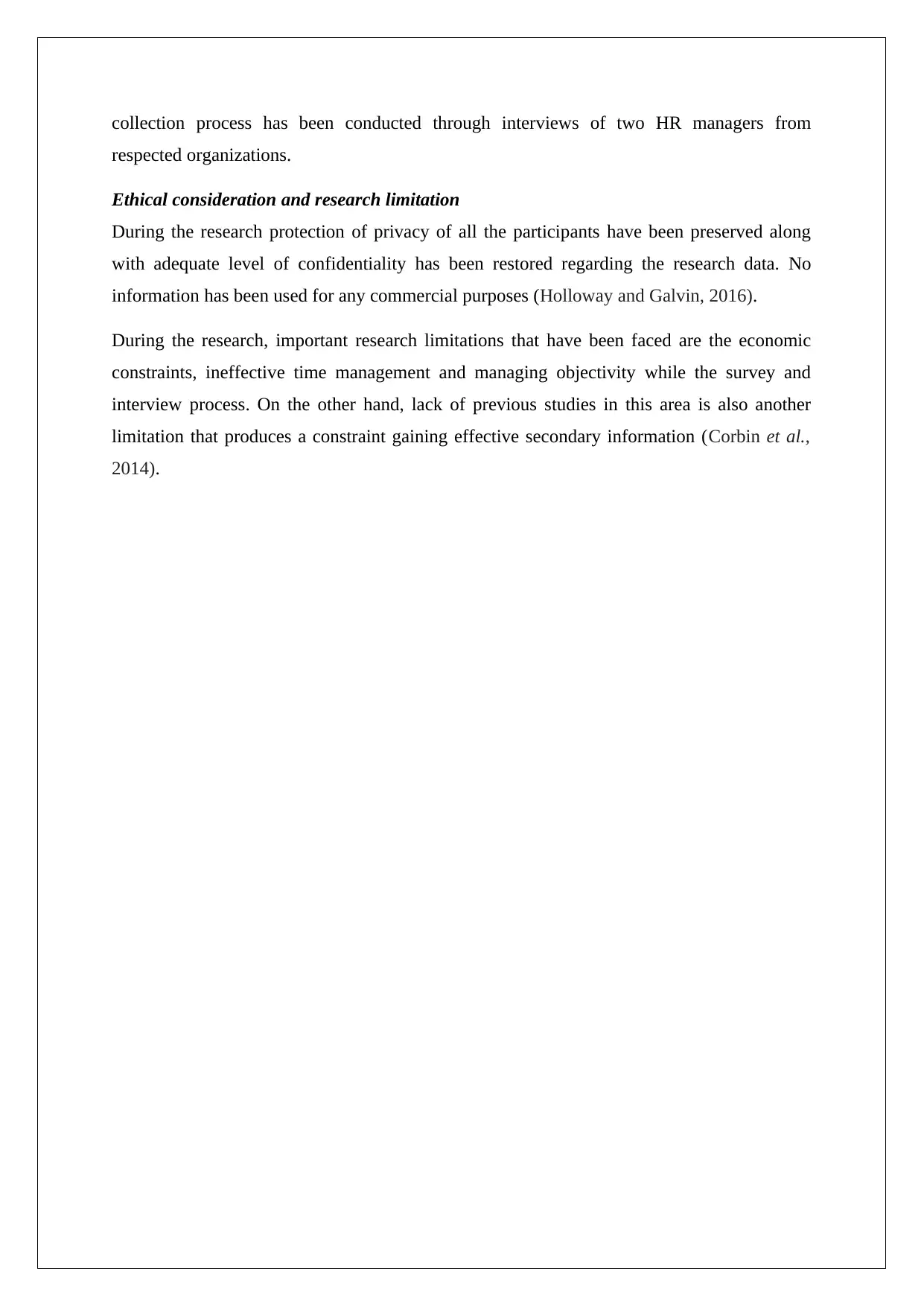
collection process has been conducted through interviews of two HR managers from
respected organizations.
Ethical consideration and research limitation
During the research protection of privacy of all the participants have been preserved along
with adequate level of confidentiality has been restored regarding the research data. No
information has been used for any commercial purposes (Holloway and Galvin, 2016).
During the research, important research limitations that have been faced are the economic
constraints, ineffective time management and managing objectivity while the survey and
interview process. On the other hand, lack of previous studies in this area is also another
limitation that produces a constraint gaining effective secondary information (Corbin et al.,
2014).
respected organizations.
Ethical consideration and research limitation
During the research protection of privacy of all the participants have been preserved along
with adequate level of confidentiality has been restored regarding the research data. No
information has been used for any commercial purposes (Holloway and Galvin, 2016).
During the research, important research limitations that have been faced are the economic
constraints, ineffective time management and managing objectivity while the survey and
interview process. On the other hand, lack of previous studies in this area is also another
limitation that produces a constraint gaining effective secondary information (Corbin et al.,
2014).
⊘ This is a preview!⊘
Do you want full access?
Subscribe today to unlock all pages.

Trusted by 1+ million students worldwide
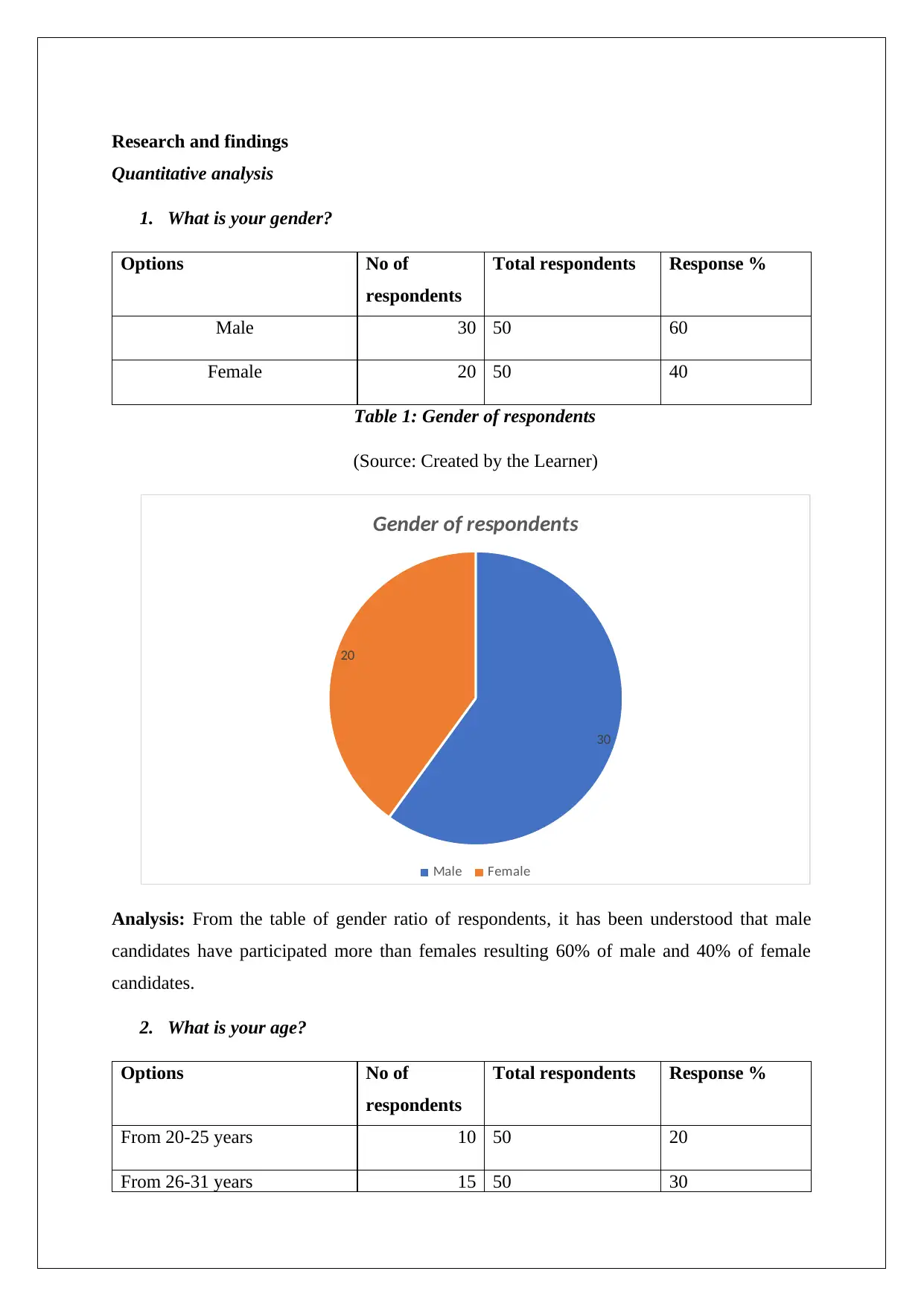
Research and findings
Quantitative analysis
1. What is your gender?
Options No of
respondents
Total respondents Response %
Male 30 50 60
Female 20 50 40
Table 1: Gender of respondents
(Source: Created by the Learner)
30
20
Gender of respondents
Male Female
Analysis: From the table of gender ratio of respondents, it has been understood that male
candidates have participated more than females resulting 60% of male and 40% of female
candidates.
2. What is your age?
Options No of
respondents
Total respondents Response %
From 20-25 years 10 50 20
From 26-31 years 15 50 30
Quantitative analysis
1. What is your gender?
Options No of
respondents
Total respondents Response %
Male 30 50 60
Female 20 50 40
Table 1: Gender of respondents
(Source: Created by the Learner)
30
20
Gender of respondents
Male Female
Analysis: From the table of gender ratio of respondents, it has been understood that male
candidates have participated more than females resulting 60% of male and 40% of female
candidates.
2. What is your age?
Options No of
respondents
Total respondents Response %
From 20-25 years 10 50 20
From 26-31 years 15 50 30
Paraphrase This Document
Need a fresh take? Get an instant paraphrase of this document with our AI Paraphraser
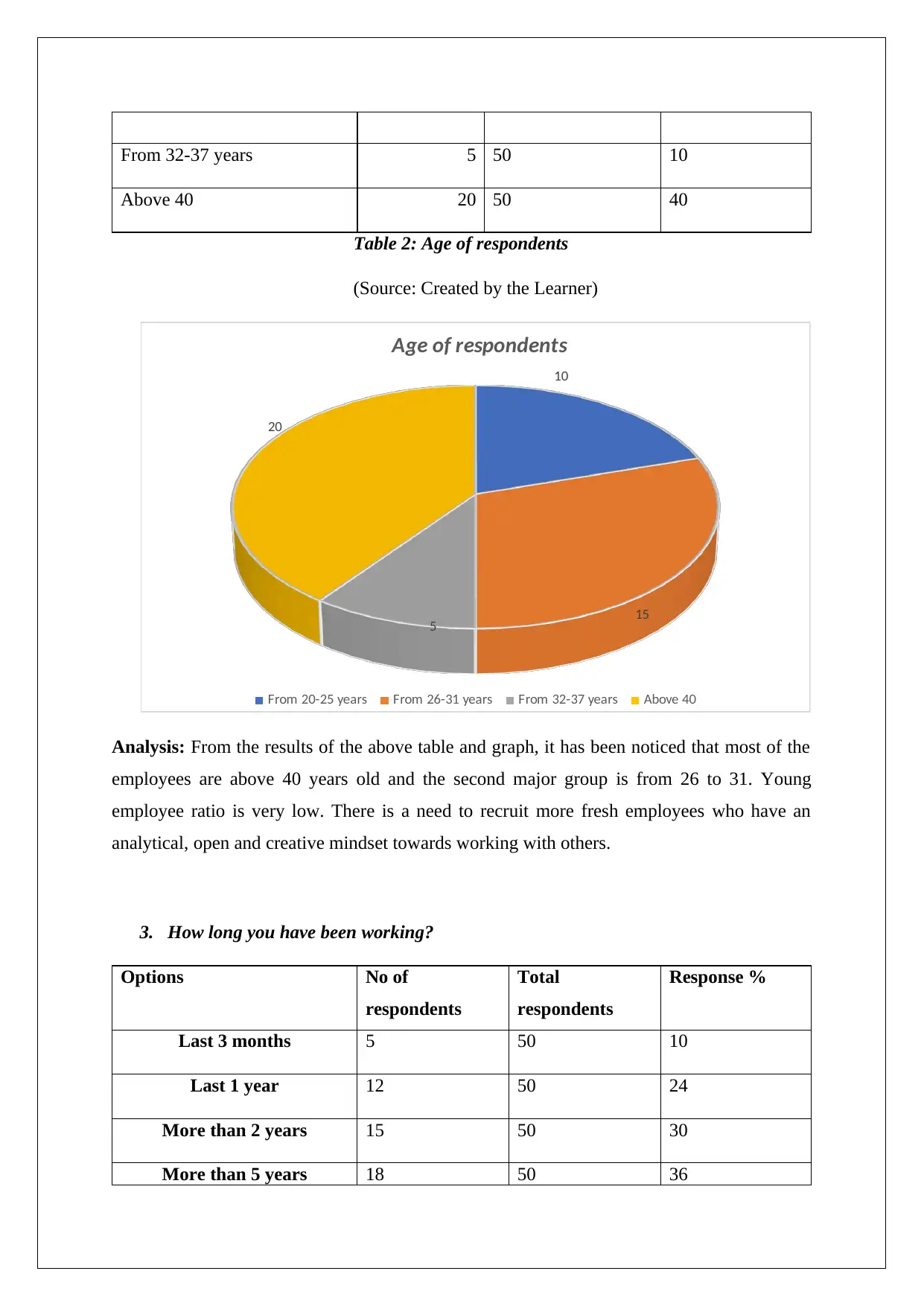
From 32-37 years 5 50 10
Above 40 20 50 40
Table 2: Age of respondents
(Source: Created by the Learner)
10
15
5
20
Age of respondents
From 20-25 years From 26-31 years From 32-37 years Above 40
Analysis: From the results of the above table and graph, it has been noticed that most of the
employees are above 40 years old and the second major group is from 26 to 31. Young
employee ratio is very low. There is a need to recruit more fresh employees who have an
analytical, open and creative mindset towards working with others.
3. How long you have been working?
Options No of
respondents
Total
respondents
Response %
Last 3 months 5 50 10
Last 1 year 12 50 24
More than 2 years 15 50 30
More than 5 years 18 50 36
Above 40 20 50 40
Table 2: Age of respondents
(Source: Created by the Learner)
10
15
5
20
Age of respondents
From 20-25 years From 26-31 years From 32-37 years Above 40
Analysis: From the results of the above table and graph, it has been noticed that most of the
employees are above 40 years old and the second major group is from 26 to 31. Young
employee ratio is very low. There is a need to recruit more fresh employees who have an
analytical, open and creative mindset towards working with others.
3. How long you have been working?
Options No of
respondents
Total
respondents
Response %
Last 3 months 5 50 10
Last 1 year 12 50 24
More than 2 years 15 50 30
More than 5 years 18 50 36
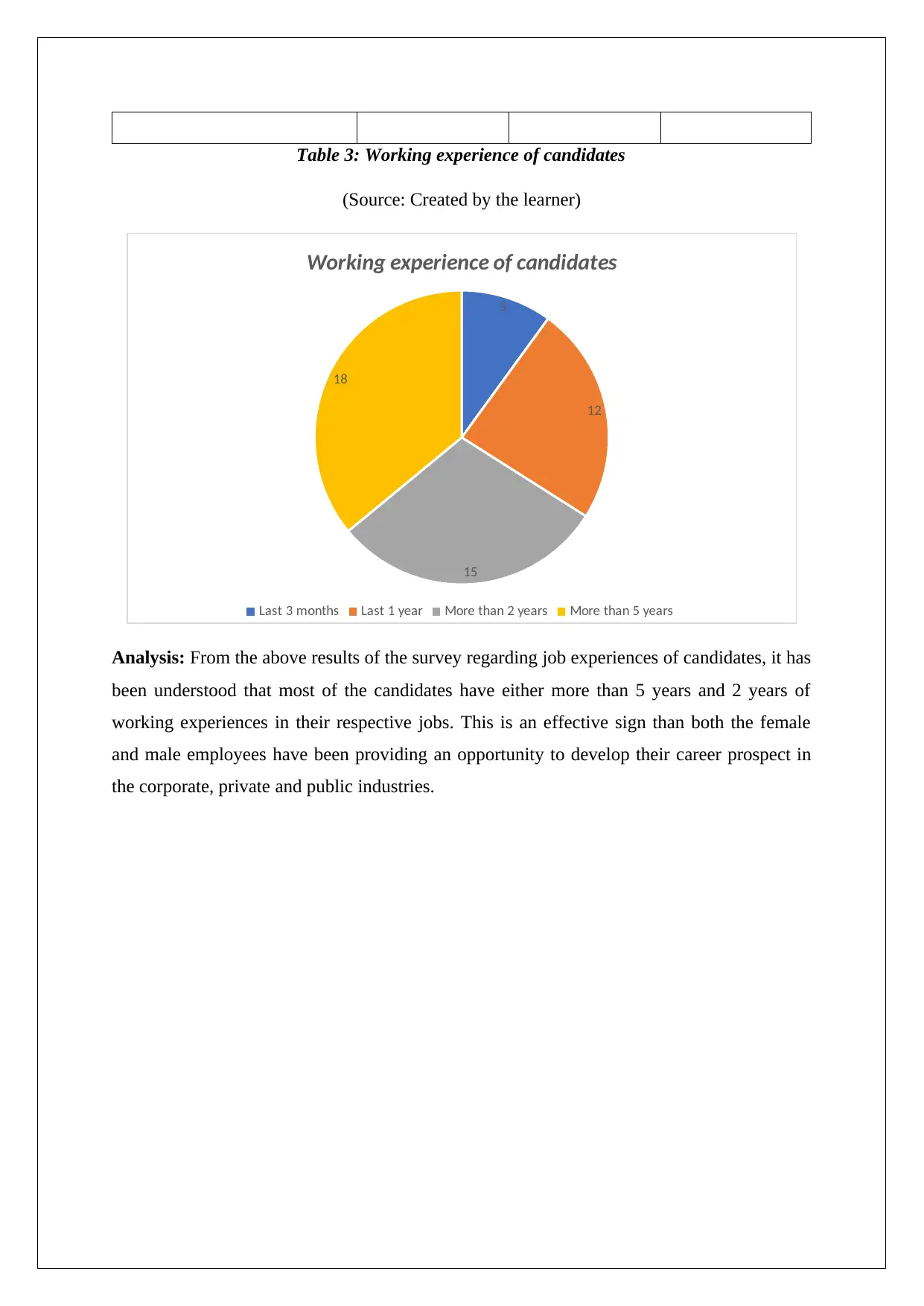
Table 3: Working experience of candidates
(Source: Created by the learner)
5
12
15
18
Working experience of candidates
Last 3 months Last 1 year More than 2 years More than 5 years
Analysis: From the above results of the survey regarding job experiences of candidates, it has
been understood that most of the candidates have either more than 5 years and 2 years of
working experiences in their respective jobs. This is an effective sign than both the female
and male employees have been providing an opportunity to develop their career prospect in
the corporate, private and public industries.
(Source: Created by the learner)
5
12
15
18
Working experience of candidates
Last 3 months Last 1 year More than 2 years More than 5 years
Analysis: From the above results of the survey regarding job experiences of candidates, it has
been understood that most of the candidates have either more than 5 years and 2 years of
working experiences in their respective jobs. This is an effective sign than both the female
and male employees have been providing an opportunity to develop their career prospect in
the corporate, private and public industries.
⊘ This is a preview!⊘
Do you want full access?
Subscribe today to unlock all pages.

Trusted by 1+ million students worldwide
1 out of 20
Related Documents
Your All-in-One AI-Powered Toolkit for Academic Success.
+13062052269
info@desklib.com
Available 24*7 on WhatsApp / Email
![[object Object]](/_next/static/media/star-bottom.7253800d.svg)
Unlock your academic potential
Copyright © 2020–2025 A2Z Services. All Rights Reserved. Developed and managed by ZUCOL.





